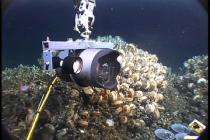Investigating potentially hidden damages in the Gulf of Mexico

Chuck Fisher, Penn State professor of biology, is familiar with the Gulf of Mexico, and more specifically with the unique and rarely seen world miles below the surface. Following the Deepwater Horizon drilling rig disaster that resulted in a massive oil spill there, concerns arose about the potential for long term damage to the sea floor and it's inhabitants.
Now, Fisher and a team of scientists from across the nation are investigating how the unique life forms that dwell deepest in the Gulf are adapting and surviving.
The floor of the Gulf of Mexico is the leading oil producing region in the continental United States. It is also home to one of the most complex continental shelves in the world. Comprised of oil and gas bearing shale, with a salt sheet underneath and a large layer of sea sediment on top, the Gulf bed has been continuously cracking and shifting since the Jurassic Period. This results in a natural and slow seepage of gas and oil throughout the sea floor.
The communities of deep sea life Fisher has studied for the past decade adapt naturally to the oil seeps that have risen from the sea floor for thousands of years. The question is whether oil dispersed by the Deepwater Horizon disaster has settled on the sea floor, and has there been any damage done to the coral reefs, sea shelves and inhabitant communities. Fisher will lead a team of scientists on a National Oceanic & Atmospheric Administration expedition to the Gulf to revisit the sea floor and try to determine if there are any present risks to the world miles below the surface of the Gulf.
Provided by Pennsylvania State University



















